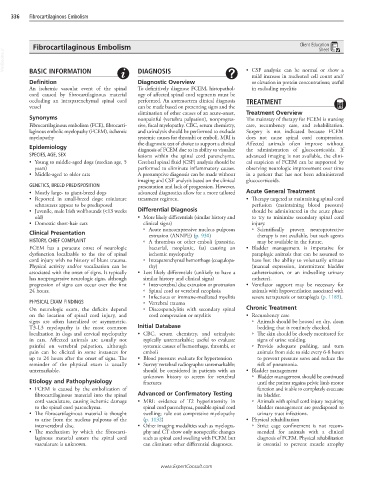Page 721 - Cote clinical veterinary advisor dogs and cats 4th
P. 721
336 Fibrocartilaginous Embolism
Fibrocartilaginous Embolism Client Education
Sheet
VetBooks.ir
• CSF analysis: can be normal or show a
BASIC INFORMATION
DIAGNOSIS
mild increase in nucleated cell count and/
Definition Diagnostic Overview or elevation in protein concentrations; useful
An ischemic vascular event of the spinal To definitively diagnose FCEM, histopathol- in excluding myelitis
cord caused by fibrocartilaginous material ogy of affected spinal cord segments must be
occluding an intraparenchymal spinal cord performed. An antemortem clinical diagnosis TREATMENT
vessel can be made based on presenting signs and the
elimination of other causes of an acute-onset, Treatment Overview
Synonyms nonpainful (vertebra palpation), nonprogres- The mainstay of therapy for FCEM is nursing
Fibrocartilaginous embolism (FCE), fibrocarti- sive, focal myelopathy. CBC, serum chemistry, care, recumbency care, and rehabilitation.
laginous embolic myelopathy (FCEM), ischemic and urinalysis should be performed to exclude Surgery is not indicated because FCEM
myelopathy systemic causes for thrombi or emboli. MRI is does not cause spinal cord compression.
the diagnostic test of choice to support a clinical Affected animals often improve without
Epidemiology diagnosis of FCEM due to its ability to visualize the administration of glucocorticoids. If
SPECIES, AGE, SEX lesions within the spinal cord parenchyma. advanced imaging is not available, the clini-
• Young to middle-aged dogs (median age, 5 Cerebral spinal fluid (CSF) analysis should be cal suspicion of FCEM can be supported by
years) performed to eliminate inflammatory causes. observing neurologic improvement over time
• Middle-aged to older cats A presumptive diagnosis can be made without in a patient that has not been administered
imaging and CSF analysis based on the clinical glucocorticoids.
GENETICS, BREED PREDISPOSITION presentation and lack of progression. However,
• Mostly large- to giant-breed dogs advanced diagnostics allow for a more tailored Acute General Treatment
• Reported in small-breed dogs: miniature treatment regimen. • Therapy targeted at maintaining spinal cord
schnauzers appear to be predisposed perfusion (maintaining blood pressure)
• Juvenile, male Irish wolfhounds (<13 weeks Differential Diagnosis should be administered in the acute phase
old) • More likely differentials (similar history and to try to minimize secondary spinal cord
• Domestic short-hair cats clinical signs) injury.
○ Acute noncompressive nucleus pulposus ○ Scientifically proven neuroprotective
Clinical Presentation extrusion (ANNPE) (p. 930) therapy is not available, but such agents
HISTORY, CHIEF COMPLAINT ○ A thrombus or other emboli (parasitic, may be available in the future.
FCEM has a peracute onset of neurologic bacterial, neoplastic, fat) causing an • Bladder management is imperative for
dysfunction localizable to the site of spinal ischemic myelopathy paraplegic animals that can be assumed to
cord injury with no history of blunt trauma. ○ Intraparenchymal hemorrhage (coagulopa- have lost the ability to voluntarily urinate
Physical activity and/or vocalization can be thy) (manual expression, intermittent bladder
associated with the onset of signs. It typically • Less likely differentials (unlikely to have a catheterization, or an indwelling urinary
has nonprogressive neurologic signs, although similar history and clinical signs) catheter).
progression of signs can occur over the first ○ Intervertebral disc extrusion or protrusion • Ventilator support may be necessary for
24 hours. ○ Spinal cord or vertebral neoplasia animals with hypoventilation associated with
○ Infectious or immune-mediated myelitis severe tetraparesis or tetraplegia (p. 1185).
PHYSICAL EXAM FINDINGS ○ Vertebral trauma
On neurologic exam, the deficits depend ○ Discospondylitis with secondary spinal Chronic Treatment
on the location of spinal cord injury, and cord compression or myelitis • Recumbency care
signs are often lateralized or asymmetric. ○ Animals should be housed on dry, clean
T3-L3 myelopathy is the most common Initial Database bedding that is routinely checked.
localization in dogs and cervical myelopathy • CBC, serum chemistry, and urinalysis: ○ The skin should be closely monitored for
in cats. Affected animals are usually not typically unremarkable; useful to evaluate signs of urine scalding.
painful on vertebral palpation, although systemic causes of hemorrhage, thrombi, or ○ Provide adequate padding, and turn
pain can be elicited in some instances for emboli animals from side to side every 6-8 hours
up to 24 hours after the onset of signs. The • Blood pressure: evaluate for hypertension to prevent pressure sores and reduce the
reminder of the physical exam is usually • Survey vertebral radiographs: unremarkable; risk of pneumonia.
unremarkable. should be considered in patients with an • Bladder management
unknown history to screen for vertebral ○ Bladder management should be continued
Etiology and Pathophysiology fractures until the patient regains pelvic limb motor
• FCEM is caused by the embolization of function and is able to completely evacuate
fibrocartilaginous material into the spinal Advanced or Confirmatory Testing its bladder.
cord vasculature, causing ischemic damage • MRI: evidence of T2 hyperintensity in ○ Animals with spinal cord injury requiring
to the spinal cord parenchyma. spinal cord parenchyma, possible spinal cord bladder management are predisposed to
• The fibrocartilaginous material is thought swelling; rule out compressive myelopathy urinary tract infections.
to arise from the nucleus pulposus of the (p. 1132) • Physical rehabilitation
intervertebral disc. • Other imaging modalities such as myelogra- ○ Strict cage confinement is not recom-
• The mechanism by which the fibrocarti- phy and CT show only nonspecific changes mended for animals with a clinical
laginous material enters the spinal cord such as spinal cord swelling with FCEM but diagnosis of FCEM. Physical rehabilitation
vasculature is unknown. can eliminate other differential diagnoses. is essential to prevent muscle atrophy
www.ExpertConsult.com

